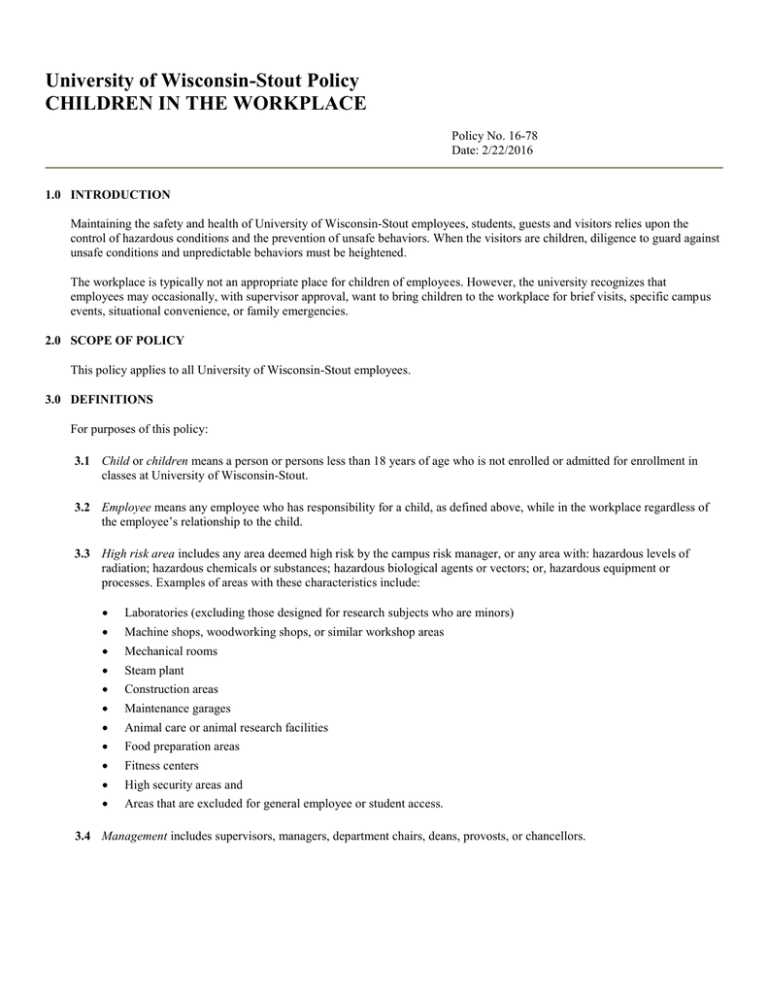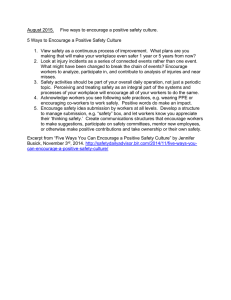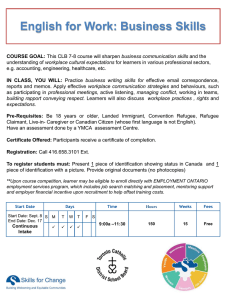University of Wisconsin-Stout Policy CHILDREN IN THE WORKPLACE
advertisement

University of Wisconsin-Stout Policy CHILDREN IN THE WORKPLACE Policy No. 16-78 Date: 2/22/2016 1.0 INTRODUCTION Maintaining the safety and health of University of Wisconsin-Stout employees, students, guests and visitors relies upon the control of hazardous conditions and the prevention of unsafe behaviors. When the visitors are children, diligence to guard against unsafe conditions and unpredictable behaviors must be heightened. The workplace is typically not an appropriate place for children of employees. However, the university recognizes that employees may occasionally, with supervisor approval, want to bring children to the workplace for brief visits, specific campus events, situational convenience, or family emergencies. 2.0 SCOPE OF POLICY This policy applies to all University of Wisconsin-Stout employees. 3.0 DEFINITIONS For purposes of this policy: 3.1 Child or children means a person or persons less than 18 years of age who is not enrolled or admitted for enrollment in classes at University of Wisconsin-Stout. 3.2 Employee means any employee who has responsibility for a child, as defined above, while in the workplace regardless of the employee’s relationship to the child. 3.3 High risk area includes any area deemed high risk by the campus risk manager, or any area with: hazardous levels of radiation; hazardous chemicals or substances; hazardous biological agents or vectors; or, hazardous equipment or processes. Examples of areas with these characteristics include: Laboratories (excluding those designed for research subjects who are minors) Machine shops, woodworking shops, or similar workshop areas Mechanical rooms Steam plant Construction areas Maintenance garages Animal care or animal research facilities Food preparation areas Fitness centers High security areas and Areas that are excluded for general employee or student access. 3.4 Management includes supervisors, managers, department chairs, deans, provosts, or chancellors. 4.0 STATEMENT OF POLICY This policy addresses the factors to consider when allowing an employee to bring a child into the workplace. Circumstances in which employees want to bring children into the workplace generally fall into the following acceptable categories: 1. Brief visits (e.g., an employee brings his/her child, grandchild or other minor relative in to introduce that child to coworkers). 2. Specific campus events that are employer-sanctioned and at which attendance by children is encouraged (e.g. Take Your Child to Work Day). 3. In the event of an emergency. 5.0 GUIDELINES FOR IMPLEMENTATION 5.1 Abuse of policy. Children are not to be brought to the workplace on a regular basis in lieu of childcare. 5.2 High risk areas. Children are not allowed in high risk areas, as defined in this policy, unless an exception has been agreed to by management of the area and the institutional risk or safety officer. Even children excluded from this policy, as stated above, are not allowed in high-risk areas, unless an exception exists. 5.3 Responsibilities. Generally, an employee who brings a child into the workplace shall not leave the child unsupervised. Employees are responsible for verifying with their manager the circumstances under which children are allowed in their specific workplace. If management allows the occasional workplace visit of children to the workplace, both the employee responsible for the child and workplace management must accept certain responsibilities (listed below) to protect the welfare of the child and the integrity of the workplace. An employee who brings a child to the workplace must: Be responsible for obtaining management approval; Be the individual who primarily supervises and cares for the child while in the workplace; Prevent any breach of confidential information; Address with management any issues related to a child’s infectious disease; and Accept full responsibility for all aspects of the child’s behavior, including safety of the child, disruption to co-workers, unauthorized or inappropriate use of university resources, and any damage to property or injury to persons. 5.4 Management must: Determine that either hazards are not likely to exist, or that hazards can be controlled under the circumstances in which the child will be present; Address potential issues of possible disruption to co-workers in the workplace; Consider the extent to which the child’s presence in the workplace poses a risk of breaching confidentiality of information in the workplace; Consider the extent to which the child’s presence is appropriate to the specific work being accomplished; and Consider the health of co-workers before an employee is allowed to bring a child with an infectious disease to the workplace. 5.5 Denial of permission. Notwithstanding the exceptions provided by this policy, management has the authority to deny the presence of children in the workplace. Management may revoke previously granted permission for the employee to bring the child to the workplace (e.g., the child’s presence is later determined to be disruptive to the workplace). 5.6 Violations. Any employee who violates this policy may be subject to disciplinary action up to and including termination of employment following the appropriate procedures and due process as outlined in the applicable handbook. 5.7 Exclusions. Except as provided elsewhere in this policy or in other university policies, laws and regulations that limit access to or otherwise regulated high-risk areas, this policy does not apply when a child: Is enrolled or admitted as a university student Is employed by the university Is attending a university-sanctioned childcare facility Is attending a public event on campus, such as a sporting event, concert or play Is attending a university-sanctioned camp, child care program, or youth enrichment program Has a parent with a workplace assignment in which one of the conditions of the employment is residency in a campus facility, e.g., live-in resident hall director. Return to Sequential Index. If you have questions or comments, email parq@uwstout.edu.






